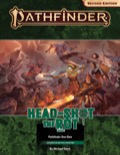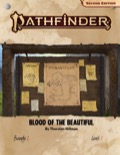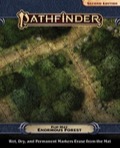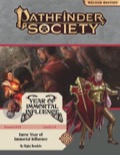Sign in to create or edit a product review. Headshot is thematic scenario that highlights the gunslinger class with a good story and some enemies that make them look good (crits!). As a one shot, I really liked the experience and I had a lot of fun. In the context of this scenario, the gunslingers were really effective, until the final battle. I think Paizo made this product to showcase the gunslinger, but it did the exact opposite, everyone left thinking gunslingers are an awful and weak class. Congratulations Paizo! You’ve made pregens that are weaker and less effective than Harsk! The backstory and personality of each pregen was OK, but I’ve seen better from Paizo. As is often the case, important details are left out (like Scatter) and players are left to look everything up. Also, PCs need to swap gear to be more effective. The art for the pregens was good. I believe we were done in 2.5 hours. It could have been sooner, but the boss fight took a long time, gunslinger damage is just abysmal. We also started late and reviewed the pregens for awhile, so it could be done in 2 hours or less. Overall: This was a really fun experience and I recommend it to everyone. (8/10) 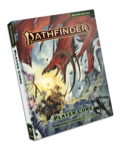
Pathfinder Player CorePaizo Inc.Add Print Edition $59.99 Add PDF $19.99
Add
Non-Mint
Player Core misses the opportunity to rebalanceJason S —This review is written from the perspective of a longtime Pathfinder 1 and 2 player and GM (and 40 years of D&D and other RPGs). If you see my review of the Core Rulebook, I feel that Pathfinder 2 is a great game, my favorite game. If you own the Core Rulebook, there’s no need to buy the remaster, either version will do, but this book is the latest. Basically, the remaster was created so that it's different enough from D&D so that Paizo can avoid legal problems. While this game is still Pathfinder 2, player core 1 missed the opportunity to rebalance the game properly. Instead they buffed classes that didn’t need it (clerics, rogues, barbarians, champions) and nerfed spellcasters even more (cantrips) when they should have been buffed. For someone who has been playing D&D (and Pathfinder) since both games were created, the new spell names aren’t intuitive. For example, they changed “Magic Missile” to “Force Barrage”. Why not just call it “Force Missiles” like the card game does? Another example, “Bag of Holding” is now “Spacious Pouch”, but why not change it to “Bag of Storage”? At least then everyone would know what it is, and converting to the new names would be much easier. Currently, convention players are trying to use the new names, but the new names are just plain bad, and everyone reverts to using the old names. For example, the Rogue feat "Gang Up" was buffed even though it was already a must have for rogues and rogues are one of the most powerful classes in a game that is skill centric. This book also buffed clerics (healing font no longer depends on CHR), which is good, but clerics already had twice the spell pool as other casters and were already arguably the best spellcaster. What about other classes (alchemist, gunslinger, monk, swashbuckler, wizard), and especially spells in general? Player Core changed cantrips that target AC and reduced their damage for some bizarre reason, even though spellcasters were already doing significantly less damage than martials. They also removed the ability modifier from the damage and replaced it with another die. Spellcasters needed less variability, not more, because there’s nothing worse than “critting” for a few points of damage (I crit for 4 damage this weekend with Spiritual Weapon) while martials blast away for 30+ damage. If they were going to reduce the damage of cantrips, the least they could do is reduce cantrips (that target AC) to 1 action, which would give spellcasters more tactical choices, and make them more even with martials (even if they still do 50% of the damage). It makes sense since everyone is now targeting AC and there is an even playing field. As you can probably tell, I feel like the remaster was a wasted opportunity to fix some problems with PF2. In high level PFS, you only see certain classes. Also, although I know it was done mostly for the ORC license, it reminded me of D&D 3.5. It was too early for a new or updated edition. Infiltration is a quest with a bit of everything, including subsystems. I think this scenario used the infiltration subsystem. It doesn’t feel organic or realistic as we investigate and prepare to break into the warehouse. Also, we earned so many Edge points (9-12?), it was basically impossible to fail the mission before we even started (Edge points can be used to get an auto success, even if you fail a roll. We had plenty of Edge points left over at the end of the scenario). Infiltrating the base also used subsystems instead of just using the map. For example, we needed to bypass a locked door, one of us picked the lock, but all of us had to do something to "help", so we had multiple people picking the lock at the same time, 2 other PCs smashing the door, another PC shooting the lock, and another PC doing something else. This is just stupid and needs to stop already. It’s because of this and other problems that persist in PFS that my group will be exploring other game systems. The art for the Silver Devil is really bad. Played at subtier 3-4 and it ran in 1.5 hours, but could have run faster with more concrete facts. I like the 2 hour quest format for kids. Overall: It could have been better without subsystems. (3/10) Respect is a long quest that has everything in it (except for subsystems) and especially a lot of combat. Respect is hard to review. On one hand, I think some players will give it a 2 star review, because it has far too much content in it. It is a scenario basically, it took us 3 hours (in a 2 hour slot), we rushed, we bypassed 2 encounters, and we were a fast and optimized group. There were 5 potential combat encounters! There was also roleplay, lore, and investigation. On the other hand, I really liked what the author was doing. The story was very good. The lore was interesting. The roleplaying was well done. The song underground was good. The art for the final boss was great. The experience was really good, if rushed. So I'm basing my rating on that. The author probably needs to write scenarios instead of quests. My group didn’t find the combats challenging, which was OK because there were a lot of them. We played at subtier 3-4 with 4th level characters. Overall: A very flavorful quest that probably should have been a scenario. (8/10) Envy is a classic sandbox scenario with a mix of everything (investigation, combat, roleplay). In the right hands, Envy is one of the best scenarios from seasons 1-6. We need more scenarios like this. This might be my favorite scenario from PFS2. I would agree with other reviewers, Envy is NOT a good scenario for new GMs or GMs that cannot handle sandbox scenarios or ambiguity. It should be fine for new players if the GM is good, I’d say it’s an amazing experience actually. Envy is a scenario without subsystems, and the game is much better without them. Envy is just a really good story with good characters that is fun to play. It has an open style that allows for many solutions to any given problem. I’ve run it 3 times and each time it runs very differently. That’s how you know you have a good story. Envy isn’t without problems however:
2) There is a small chance of gaining infamy, although it doesn’t make sense, and it’s undeserved. In addition, if the action was successful, no one (except your fellow Pathfinders) would know. Any rumors would never leave this evil city and wouldn’t really affect the rest of the world. Whoever wrote this into the scenario was really trying to force infamy into it. Why does PFS constantly try to force infamy into scenarios? 3) Although the writing is good and clear (and could be run cold), the information is very condensed and takes significant time for a GM to prep to run properly. 4) The obstacles at the end are too contrived and it’s enough stress just getting through the checkpoint without weird coincidences. 5) It will probably run long, 5 hours. ”Detailed rating”:
Length: Long. 5 hours. Experience: GM 3 times, all at subtier 1-2. Sweet Spot: Both should be OK. Ironically, this scenario is MUCH easier at subtier 3-4 because you have more spells to solve problems, as well NPCs give you items that help a lot (potion of invisibility). Entertainment: A very interesting and intense rescue mission. (10/10) Story: Good lore, good setting, good NPCs. (10/10) Roleplay: Lots of ORGANIC roleplay. No subsystems. (10/10) Combat/Challenges: The combats are nothing special and the GM will need to do some work to make them better. (8/10) Maps: Good, although it’s up to the GM to get maps for other locations. (7/10) Boons: n/a. (n/a) Uniqueness: First rescue mission that made sense, in a unique setting. (9/10) GM Preparation: It will take work and thought to prepare properly for this sandbox. Overall: Envy is one of the most enjoyable PF2 scenarios and I wish we had more like this. (9/10) Blood is a quick investigation followed by a challenging combat. The investigation portion of the bounty was OK, but nothing special. The combat was challenging because of the terrain, although it was never a factor for my group and they beat it easily. I didn't really understand how the terrain and tactics of the opponent worked together to make an interesting encounter. This bounty is guaranteed to run in 1 hour. Hoard is a very short and easy combat scenario with a long chase scene. What eddv said. The combats weren’t memorable, there was no roleplay, and the chase scene wasn’t that interesting. There weren’t any decisions to make, or anything to think about. I’m pretty sure this scenario will be played 100% the same no matter which party goes through it. Yawn. Also, the second combat, I don’t really think that any creature who comes out of the chrysalis stage should be at 100% strength immediately. It doesn’t make any sense. I thought of Aliens, but the chestbursters are quite small when they emerge. We didn’t even get a gory description of the plight of those who were captured. Maybe that would have been interesting. Or maybe it would have been interesting to save someone and have them limp along during the chase, forcing us to make a decision. PFS2 just lacks story. Played at low subtier. Overall: A short unmemorable scenario. (5/10) 
Pathfinder Society Scenario #6-12: The Burning of GreensteeplesPaizo Inc.Our Price: $8.99 Add to CartA simple but good storyGreensteeples is a combat scenario with a skill gauntlet at the start. One of the problems with Greensteeples was that it had no context. What is Greensteeples? Why do we care? Why was the lodge being attacked? Why were people left behind? We slowly got this information by asking questions, but the mission was not clear or clearly written. The faction missions didn’t add anything to the session and added unnecessary confusion. Other than being confusing, the story was really basic. The skill gauntlet had some good ideas, but the way they are implemented in PFS2 (seasons 2+), they lack a soul. A bunch of meaningless skills checks. Give us a problem and let us come up with a solution. The combats took a long time and one was very challenging (it was Severe and close to a wipe). We finished in 4.5 hours and rushed the ending. Overall: A simple but good story with a challenging combat encounter (7/10) I'd buy this, because we really need an enormous forest map, but you continue to put rivers in every forest map. Also, we have a lot of forests with roads, how about a forest that is just ... forest, with slopes and other difficult terrain? Check out your local forest, it's almost all difficult terrain, yet our maps look they are flat combat fields. 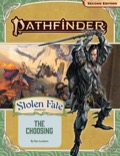
Pathfinder Adventure Path #190: The Choosing (Stolen Fate 1 of 3)Paizo Inc.Add Print Edition $26.99 Add PDF $19.99 Non-Mint Unavailable Classic feelPerspective: A player who jumped in 1/2 way through the book. Although the concept of this AP is a little cliché (find all the McGuffins), I was drawn into the plot very easily. The overall idea behind the AP is interesting and compelling to play. This book starts with the influence system, which I dislike and is a terrible way to start an AP, but the GM discarded the influence system, made it roleplay and much shorter. Most of the encounters were well done, with interesting mechanics. However, one encounter was against a CR 14 creature (after fighting an encounter 1 round before it), at level 11. We actually brought 6 characters (the AP was designed for 4 characters at level 11), three of whom were level 12, into the encounter and we barely made it. I thought this was too challenging. Your home base, that gets upgraded over time, was very interesting and has a lot of potential for mystery. Overall: Besides the influence system and an encounter that seems too dangerous, I found this to be an interesting start to the AP and something I’d want to play. (9/10) 
Pathfinder Quest (Series 2) #16: The Winter Queen's DollhousePaizo Inc.Our Price: $5.99 Add to CartFun for all agesDollhouse is a roleplaying quest. Dollhouse has some great characters in it. I love the custom art as well. The roleplaying isn’t ruined by the influence system. It is on the cute side, but it was appropriate. Overall: A great roleplaying quest, but like any roleplay scenario, it all depends on how well the GM portrays the NPCs and if the players like roleplay. (9/10) Influence is a mix of combat, roleplay, and skill challenges. I didn’t like the story in this scenario at all. Hang around a party until the evil guys do something evil, fix what the evil guys are doing, have the evil guys smile and giggle the entire time, have evil guys accuse you of wrongdoings, evil guys repeat and do it again and again. There’s no PC agency, just the PCs reacting to one situation after situation, forced to go with the flow. Before anything happens, do some random side quests for NPCs you-don’t-know, because you are afraid of losing treasure bundles. The auction quest should have had a high chance of failure. Performing this criminal act was extremely embarrassing for the PF society (successful or not successful, word will get around) and damaging for our reputation. Despite spending significant time with various major NPCs, I didn’t fully understand who they were, what their organization does, or why they are important. Everything about this scenario felt forced and I didn't feel like there was room for player choice. ”Many things didn’t make sense”:
If we stop two demonic encounters, when someone screams "the Pathfinders are going to kill everyone", why is the crowd scared of level 1 characters? Why would they suspect Pathfinders of mass murder, and if so why were we invited to the party? If they were validly scared, why are they still at the party after the first attack? Where are their bodyguards? If they fear us, why would they want to run TOWARDS us? How did a low-level cleric perform a ritual to kill party goers without the party goers knowing about it? That’s high-level magic (that doesn’t exist to my knowledge), and even if it could even be performed, why would they waste it here? Why would a planar restaurant be deemed safe when Absalom isn’t safe? Why would the party continue without at least level 1 bodyguards? Why would a single bug, less than the size of a dinner plate, be able to do 20 hit points of damage (with no crits) to a 1st level character, dropping her to 0 hit points before she can even act? Maybe if the bug was larger?
Overall: This might be OK if you don’t think too much about it and just follow the breadcrumbs. (5/10) 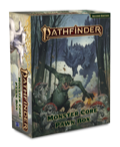
Pathfinder Monster Core Pawn BoxPaizo Inc.Add Print Edition $74.99 Add PDF $9.99 Non-Mint Unavailable Must haveThis product is a must have for the Pathfinder game. It has all the minis you need to run most Pathfinder games. Even if it doesn't contain the exact creature you need, it contains a pawn that's similar enough. This product has especially good value if you're on a budget. Although I have many plastic and paper minis, this is still a useful accessory. If you already own a Bestiary pawn box, there are probably not enough changes in this one to make it worthwhile. This pawn box has the same great quality of previous pawn boxes. The art is great, the bases and pawns are sturdy. It contains a large amount of black bases: 20 small/medium, 10 large, and 5 huge bases. A great value. Port is a quest with a mix of everything. I liked the background and information about the Shackles contained in this scenario, which made the scenario (and roleplay) come alive. The scenario started however, in an awkward way. We’re on an important mission, but yet our Pathfinder ship drops us off in the middle of the ocean on a sandbar, miles away from shore (without any explanation)? To make things worse, they tell us to jump overboard and swim to the sandbar in deep but calm water in our armor (no mention of whether the contract is waterproof, just that it’s sealed). We’re told to wait there for an undetermined amount of time for someone to pick us up. During this time, the water rises and covers the sandbar with 2 inches of water, submerging our feet while we wait, preventing us from even sitting down. Hours later, a local fisherman picks us up in his rowboat, but do we go directly to Port Peril? Nope, of course not, we make numerous stops along the way catching crabs. But it doesn’t end there. Once the mission is finished, you escape and take that same fisherman’s boat back to the sandbar and sleep the night on the sandbar, which may or may not be flooded with water. Then, you wait an entire day on the sandbar for another ship. I’m not sure what feeling the author was going for, but I couldn’t help but feel disrespected, treated like dirt. If this were a real campaign, this would be the last mission my PC would perform for the Pathfinder Society. Anyway... ”After reading the quest, I felt like too many details were not provided.”:
For example, in The Last Chance, the DCs for swimming and climbing should have been provided. Is the scroll waterproof (because we ended up swimming away instead of fighting)? Why was it important to leave us on a sandbar? The combat at subtier 1-2 was very easy. Love the maps that were used. This quest has very good qualities for a repeatable. I had a new GM run Port and I thought it was too complex for her. She didn't understand the background lore, there's a unique hazard, spells, it’s too sandboxy, and there are too many details that the GM is left to improvise. It took more than 2 hours. This quest is for an experienced GM. Overall: Good lore and a sandbox a creative GM can use, but weak combat and irritating fluff. (7/10) Blackwood is a scenario with a mix of everything. This was played at subtier 3-4. It took 5 hours. I think the story was great, even if it was a little slow at first. The encounters were somewhat unique and more memorable than most. I felt the scenario (or GM?) railroaded you into certain choices and if you didn’t choose the expected choice, you were punished (lost treasure bundles). We didn’t want that, so we performed the expected skill challenge. Authors should consider skill feats when making scenarios. Our GM decided our Survival feats didn’t even allow us a bonus to a very specific Survival check. The feat should have at least resulted in a circumstance bonus, but it could have easily resulted in 4 successes instead of 1, but it wasn't clear. GM decided it did nothing. Although it's not the author’s fault, it reflected badly on the experience. The scenario had a very serious tone with very serious consequences, which was somewhat ruined by silly situations. For example, the cute Kolbolds, a dog named “Good Boy”, a sex change while starving to death on a deadly demi-plane collapsing around us, and killer green sloths. There were too many opportunities to lose treasure bundles. This was the first time in a long time I’ve lost any. Overall: A long scenario with a good story and memorable experiences, somewhat ruined by other various elements. (7/10) Hidden is slow investigation sci-fi thriller featuring mostly combat. It was played at subtier 9-10 and took 3 hours. The main problem with Hidden is that it starts really slow. A slow briefing. Lots of narration about traveling. Talking to the captain and crew (which is irrelevant). I think it took an hour before anything happened at my table. It just seems like the GM should (quickly) narrate everything until they reach the desert. The investigation itself was somewhat interesting, but it needs to be sped up. Basically, not enough happens with the amount of time you spend searching through every room. There are a lot of empty rooms. Each encounter starts off in an interesting way, but it's just cosmetic and the encounters end up being average slugfests. More Starfinder tech (and maps). If we wanted to play Starfinder, we'd be playing Starfinder. The boss encounter could be somewhat deadly. For us, we resolved it quickly and easily. This scenario could (and probably should) be really short, maybe even as short as 2 hours. The horror elements were extremely mild, I'd call them creepy. Overall: A short investigation scenario that has a sci-fi feel to it. (5/10) Lies is mystery and investigation scenario with a mix of combat, skills, and roleplay. Played at subtier 3-4. The strength in Lies is the story and especially the encounters, NPCs, maps, and mood in the latter half of the scenario. The encounters were challenging, unique, varied, and enjoyable. Lies had the most handouts I’ve seen in a scenario and although there were almost too many, they were useful. The weak part of the scenario are the skill challenges. For example, if we’re trying to break into a house and I pick the front door’s lock, why does everyone else need to pick that same lock, climb through a window, smash a door, or contort themselves through a hole? I find that absolutely ridiculous. In the same home, how many Pathfinders (and successes) does it take to clear a room of cats? Seriously? This needs a skill check? How many Pathfinders does it take to pry a single floorboard? Scenarios need to stop using subsystems where they're not applicable. We also don't need to make skill checks for tasks that my 95 year old grandfather can do. The farm was also silly. Her husband is missing and she doesn’t have enough time to talk to us until we finish her barn chores for the entire day? Yet another scenario where we take care of the kids. Babyfinder. Luckily, the rest of the scenario was great, even if it runs long (5 hours). Overall: Lies has some great encounters, NPCs, and storytelling in the latter half of the scenario. (9/10) Tapestry is a combat and skill challenge orientated scenario with plenty of reveals and PFS story lore. The good parts about Tapestry were the story lore, easy to understand box text, the reveals (I was genuinely surprised), the combats, artwork, unique opponents, no influence system, unique environments. It finished in 4.5 hours and it had an epic vibe. It also has a big effect on Golarion lore and future Pathfinder scenarios. It continues the storyline from one of Pathfinder 1s most iconic and recognizable NPCs. It’s basically everything you would expect from a level 9-12 scenario. It’s the best (or one of the best) scenario from seasons 4 and 5. On the other hand, at subtier 11-12, Tapestry was several times more difficult than any scenario I’ve played in PF2 (including The Thorned Monarch). Although we were successful, it was too difficult. It’s on the same level as “Salvation of the Sages” and other hard mode scenarios in PF1. Our group was the most optimized and twinked party I’ve seen in PF2 , our GM softballed everything, and we still barely made it. I thought our group was skilled, but we failed the skill challenges.
Mild spoilers only:
There were punishment combats, we barely made it through the first one, if the GM hadn’t been lenient, the second punishment combat had a good chance of TPKing us and even if we won, we wouldn’t have been able to finish the scenario. I don’t want to spoil, but one of the encounters had a (unique) effect that has around a 20% chance of instantly killing a PC and effects most PCs. One of our PCs died. If played straight I can see it being too challenging for many groups. It's very possible that this plays out differently at subtier 9-10. Overall: Tapestry is a dangerous epic experience, with a great story and Pathfinder society lore. Proceed with caution. (9/10) Firelight is a strong story based repeatable with an equal mix of combat and skills. This was played at subtier 7-8. The strongest part about firelight was the story and the supporting artwork. Firelight is one of the rare repeatables where it actually makes sense that it’s repeatable. It’s the first repeatable that I’d want to play again. Even the preparation for the trial (with skill challenges) made sense, although I did not enjoy taking care of children yet another time (at this point my character had taken care of children 3 scenarios in a row. Pathfinders = Babyfinders). The combat did have a unique feature but otherwise it was fairly mundane. If the combats were more unique, this would be a 5* scenario. Overall: A great story that you’d want to experience again. (8/10) Trapping is mostly a combat scenario with the influence system. This was played at subtier 7-8. I thought the overall story and handouts for Trapping were well done. The description of the trap was also well done. I found that the influence section in Trapping was contrived. Why are these NPCs withholding information? Why do we need to convince them and be friends for them to give us as much information and/or gear as possible? Especially considering that they will suffer the same (or worse) fate than we will. Also, why is Star following us around on a mission to assassinate Aslynn? Star is a complete unknown and (narratively) could have been on Aslynn’s side as much as he could have been on our side. It’s an unknown and a risk that PFS should have never taken. Starfinder content (stasian coils) was again infused into another scenario, I’m not sure why we couldn’t just stick with magic and rituals to trap Aslynn. Aslynn’s rhymes and dialogue were good as normal. The dream could have been great, but I just found it confusing and not well explained. I still don't know what happened to the Wall of Force. The skill challenge was forgettable. The biggest flaw in the scenario is unfortunately the final encounter, against Aslynn. Our group ended up killing Aslynn in 2 rounds. Yes, we were successful in the influence section, but it shouldn’t have changed the encounter into easy mode. In the end, Star seemed too child-like and his actions seemed almost comedic (instead of tragic). We just shrugged. Also how did he jump 300’+ in the air, did he have rocket packs? Honestly, I just didn't understand aspects of this scenario. ”Story inconsistencies”:
Story wise, we didn’t understand why the skull, Xerxes, was fighting for Aslynn. The GM seemed to think that this version of Xerxes was before the first scenario of season 4, which is counterintuitive considering Trapping is one of the last scenarios in the season. Also, this explanation doesn’t make sense because Aslynn would be dead before the start of the season and many of the events in the first scenario wouldn’t occur. So why was Xerxes there, or was that a generic talking skull and the GM misunderstood?
Overall: A disappointing ending to one of the most iconic villains of PFS. (6/10) Glorious is a combat scenario with a few skill challenges, that runs long (5 hours). Our session was at subtier 9-10. Glorious is an enjoyable scenario, with opponents that have powers that you don’t see much at lower levels but get used repetitively at high levels. Some of the monsters were also used repetitively. I'll agree with another review in that rare higher level creatures could have been used, creatures not seen at lower levels. The last combat had a few stages and unique events each round, which made the scenario more unique and enjoyable. There were two skill challenge sections. I didn’t find them particularly memorable and I thought that they were a little too inclusive with skills. (The results matter however). If someone wants to use a non-intuitive skill for a skill challenge, players need to put in a little effort and be creative on why the skill could be used. In practice at conventions, skill challenges that are too inclusive are just roll offs using one of your best skills, with no creativity or problem solving involved. Yawn. Overall: A good and sometimes unique combat scenario that is appropriately challenging. (7/10) Pathfinder 2 is a fun and faithful evolution to Pathfinder 1. It still has the same feel and familiarity. While I like both systems, I’ve played Pathfinder 2 for the past 5 years and it’s my preferred system. The best parts of Pathfinder 2 are three action rounds, the condensed skill list, and how easy it is to make and modify characters, while still allowing for many different character builds and options. It’s also easier to make an effective character, and more difficult to make a character that's better than everyone else's. Multi-classing is brilliant and balanced. Monsters in PF2 are improved and have unique abilities. It helps to make fights different from each other and interesting. The math around PF2 also makes it very easy to build encounters of various difficulties, which is great for homebrew GMs. Most players will appreciate how easy it is to make a character that has meaningful choices at every level. PF2 should be popular with D&D 5E players that want less generic characters. However, some players in Pathfinder 1 liked to spend hours on their character, looking through splatbooks, looking for ways to make the ultimate character. For these players, they might not like the simplicity of PF2. PF2 also cleaned up a lot of rules, which makes it easier to play. High level play also scales really well, with fast play, and isn't a burden on the GM, which is a real accomplishment. It's not all good however. I didn’t like that PF2 nerfed the classes that were too strong in PF1 (alchemist, monk archetypes, spellcasters, gunslingers) and made weak classes in PF1 too strong (rogues, barbarians, fighters). Spellcasters are further nerfed in the sense that they no longer have a niche. Most magical problems in PF2 can be solved with skills that any character can easily attain. The only nerf that was good was that ranged martials are no longer overpowered. The real failing in PF2 is that there’s too much variation in the damage output between martials and spellcasters. Spellcasters, even with cantrips, do 50% or less damage compared to martials, and it gets worse at higher levels. Spellcasters claim to fame is basically fireball. I could write an essay, but the main problem is the game nerfed the utility of most spellcasters, spellcasters don’t have the same attack modifiers as martials (less hits/crits), and spells do less damage yet take 2 actions. Except for cantrips, spells no longer improve as you level up, so the only spells that are viable are your highest spell level, which is only 3 spells, which is NOT good enough for a typical adventure day. At one time, spellcasters were "glass cannons" (less AC, HP, saves, perception) but now they do less damage, so they are just glass. At high level tables, if I see we have more than 2 spellcasters, I know we’re in trouble. Those casters are almost always clerics, because clerics get free heals at their highest level, effectively doubling their spell pool. The Core rulebook, while big and unwieldy, is one of the best purchases in the RPG market. The book itself is presented and explained very well, and is a joy to read. Pathfinder 2 is my favorite game and I love it, but I really think spellcasters need some love in the future. Poisonous is a sandbox scenario with problems that can be solved in many ways. It can be a roleplay scenario, an infiltration scenario, or a combat scenario, it depends on you. It also has a small influence section. Personally, although nothing new or unique was done in Poisonous, I thought this scenario was solid: it was well themed, had a great story, and interesting NPCs. Also, the handouts and art were very helpful. The influence section was good, mostly because the NPCs were interesting, and it wasn’t long. I still think it would be more interesting to roleplay this section than use the influence system. I found the herb part of the scenario (and the handout) to be a waste of time, irrelevant to the story. The only relevance it had was to reduce the number of treasure bundles the PCs receive. Our group went off the rails a bit and the GM abandoned the Infiltration system, which made the scenario much better. We played at subtier 3-4, chose non-combat solutions, and the scenario was just over 3 hours. If the combat approach is taken, it could run long and the combats are too easy. Overall: A good sandbox scenario with problems that can be resolved in a variety of ways. (7/10) Wall is a classic combat scenario with some investigation and some horror elements. One of the combats are tough but overall was good for subtier 7-8. In some ways the combats were redundant with other combats in this scenario and other recent scenarios. The scenario finished in 4 hours, although one non-optional encounter was skipped through good scouting. There was an influence section but it was over fairly quickly (30m), so there were no issues. I thought it was ridiculous to introduce the PCs to all of the council, with extravagant descriptions, do a few skill checks, and then have it be completely irrelevant to the scenario. Again I think the scenario would be better WITHOUT the influence system. Simple is better. I agree with the other reviewers. Overall: A fairly straightforward (but enjoyable) combat scenario. (7/10) Tapestry is a combat and skill challenge orientated scenario with plenty of reveals and PFS story lore. The good parts about Tapestry were the story lore, easy to understand box text, the reveals (I was genuinely surprised), the combats, artwork, unique opponents, no influence system, unique environments, it finished in 4.5 hours, and it had an epic vibe. It also has a big effect on Golarion lore and future Pathfinder scenarios. It continues the storyline from one of Pathfinder 1s most iconic and recognizable NPCs. It’s basically everything you would expect from a level 9-12 scenario. It’s the best (or one of the best) scenario from seasons 4 and 5. On the other hand, at subtier 11-12, Tapestry was several times more difficult than any scenario I’ve played in PF2 (including The Thorned Monarch). Although we were successful, it was too difficult. It’s on the same level as “Salvation of the Sages” and other hard mode scenarios in PF1. Our group was the most optimized and twinked party I’ve seen in PF2 and it wasn’t enough. I thought our group was skilled, but we failed the skill challenges.
”Mild spoilers only”:
There were punishment combats, we barely made it through the first one, if the GM hadn’t been lenient, the second punishment combat had a good chance of TPKing us and even if we won, we wouldn’t have been able to finish the scenario. I don’t want to spoil, but one of the encounters had a (unique) effect that has around a 20% chance of instantly killing a PC and affects most PCs. One of our PCs died. Let me repeat, our GM was softballing everything, in our favor, and we still barely completed the scenario. Overall, I thought it was a bit much and can’t see many groups making it out of this scenario. If your GM enjoys killing PCs, you’re done. It's very possible that this plays out differently at subtier 9-10. Overall: Tapestry is an epic experience, with a great story and Pathfinder society lore. Proceed with caution. (9/10)
|
|




